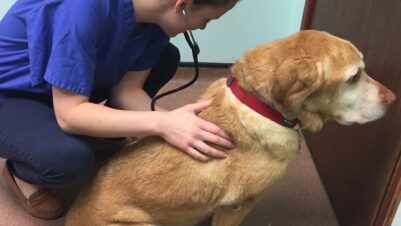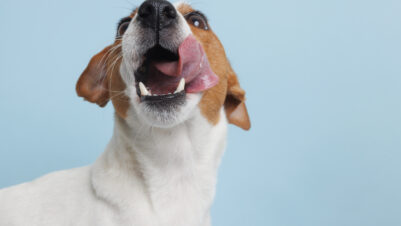
One of the biggest behavioural issues seen in dogs in grooming salons is the lack of habituation to grooming, mainly due to the absence of owner education when they originally get their puppy or dog. This often displays as fear aggression as well as various stress responses, which vary in severity.
It would make life much easier for both owner and dog if guidance was given to resolve these behavioural issues before problems develop, and if this isn’t given by the person selling/rehoming the dog (and sadly it often isn’t), the next point of contact for owners is their trusted veterinary professional that they see for vaccinations and healthcare. If basic information on grooming was passed on at this stage, so many dogs and owners could be helped.
Understanding a dog’s grooming requirements
All dogs require regular grooming – from the super hairy to the hairless – with varying degrees of consequence if this isn’t done. It is vitally important owners are aware of their dog’s grooming requirements and are given direction to accredited professionals who can help, along with basic tips on habituating their dogs to grooming at home and explanation of the benefits in establishing a regular routine to avoid any future issues. It isn’t a case of waiting until the dog is in desperate need of grooming before looking for a solution. Selecting a groomer is another important person for owners to add to their “care team” for their pet from the beginning – like a great vet!
It is vitally important owners are aware of their dog’s grooming requirements and are given direction to accredited professionals who can help
Many commendable breeders are great at advising new owners on grooming commitments for their dogs, and with “high maintenance” breeds such as the Poodle, the awareness of grooming commitments is one of the first questions prospective new owners are asked. However, many breeders are not forthcoming with advice or, worse, hand out disinformation such as “the puppy doesn’t require grooming until adult” or “these dogs are non-shedding so do not require grooming”. In my experience, this is most often seen with wool-coated cross-breeds like Cockapoos or Doodles whose owners initially believed were non-shedding and therefore low maintenance.
Creating a transferable skill
Grooming promotes a bond and creates familiarity with the dog’s body condition, coat and skin. This regular close contact increases the chance owners will pick up any issues which could lead to early diagnosis and successful treatment before they become a problem. By establishing a grooming routine, the dog becomes used to being handled – a fantastic transferable skill over many situations, such as vet and groomer visits, administering medicine or emergency first aid.
By establishing a grooming routine, the dog becomes used to being handled – a fantastic transferable skill over many situations
Prevention is better than cure with grooming. Being able to regularly pass a brush and comb through a dog’s coat has more benefits than “just” removing dead hair, health checks or improving circulation. Regular grooming also prevents the coat forming uncomfortable knots and matts, which can hide parasites and create additional skin issues such as hot spots, resulting in the inevitable groomer “shave off” when there is no other option. This process can be lengthy, uncomfortable and highly stressful for the dog, especially if they are unused to the grooming procedure, often leading to the dog requiring veterinary sedation to complete the groom safely. An emergency clip off can also create behavioural issues afterwards, as new sensations can cause the dog to create trauma as they chew, rub and over-groom themselves. I have also seen this create depressive states in dogs, particularly if they are a very long- or thick-coated breed who has had an emergency shave off as their first experience of professional grooming.
Unregulated dog care
Many owners complain their dog “tries to bite them”, “won’t stand still” or “doesn’t like the brush”, so the dog’s exposure to grooming stops there. This lack of experience and guidance can unintentionally cause the dog to negatively associate grooming with pain. The dog is then taken to a groomer who is often expected to habituate the dog to the grooming experience in a few hours, while dealing with the inevitable discomfort of removing the build-up of dead coat, knots or matts while the dog is exhibiting various unwanted behaviours due to the negative association with the grooming process. Advice given by vets at the first contact stage would be invaluable to avoid this situation.
Advice given by vets at the first contact stage would be invaluable to avoid this [dogs being taken to groomers expected to habituate the dog to the grooming experience in a few hours]
Grooming is sadly another area of dog care which is unregulated, relying on groomers to self-regulate themselves, such as by completing industry-approved training (run by approved training providers); undertaking regular CPD in subjects such as basic first aid and behaviour; and holding insurance. In my experience, many groomers are often setting up businesses with limited experience or education which can compound problems for all concerned.
Advice for vets to offer owners
The advice given here can be used for a dog at any life-stage; however, an older dog could need more work on re-establishing positive associations to the grooming process. It could be likely they have had more negative experiences and created greater complex avoidance behaviours, given they have been around longer! Establishing a regular grooming routine is important for dogs of all ages.
Suggested advice for vets to give to owners:
- Ideally encourage the owner to research the breed before purchase: in addition to the usual criteria such as exercise requirements, suitability to their lifestyle, size as an adult, etc, find out the dog’s grooming requirements and seriously consider if that is a commitment which can be met, both in time and cost
- Find a reputable, qualified, experienced and insured groomer to signpost owners to: this should ideally be one who is educated in dog behaviour, and considers socialisation and positive reinforcement at the dog’s own pace as a priority. There are industry organisations, for example The Groomers Spotlight, who hold member lists of suitably qualified professionals that meet high standards of training and care and are often a good place to signpost new owners to
- Some groomers may be only too happy to come into the practice and do a brief talk on grooming tips: this could be incorporated into socialisation visits to acclimatise new dogs to the veterinary practice (also a great idea) and could be done with a few owners and their dogs at the same time
- Encourage owners to practise handling their dog: this should include running hands over their body, picking up legs and looking at feet, eyes, ears and mouth. For smaller breeds, placing them safely on a higher surface can also be beneficial in preparation for the groomer’s table
- Using the assistance of a second person who can make the dog feel safe and secure can help give the owner (and dog) confidence: reinforcing each positive action with high-value treats is important, noting any areas which cause concern for the dog. These areas will often need extra work, breaking down the movement to a point where the dog is relaxed, then incrementally working back up to the desired action. For example, if touching a dog’s feet is not possible, starting at the point on the leg where the dog accepts touch, rewarding that and then moving slowly towards the foot and so on
- Incorporating noise: this may include a hairdryer running in the background or an electric toothbrush held gently on the dog’s body and eventually moved over the body and legs, etc; this can help to acclimatise the dog to the equipment a groomer has to use
- Enrichment toys: Lickimats or Kongs, for example, can be smeared with cottage cheese, nut butter, etc and be used as distraction or reward during any part of the grooming process, such as introducing the dog to the brush/comb/bath. The very act of licking releases endorphins which builds up a lovely positive association with being handled and groomed
- The advice/help of a behaviourist should always be sought if any part of the process is giving an owner or dog concern: using the services of a suitably qualified person to help is always positive – to give dog and owner a solid base to work on and achievable goals to reach. Some dogs who have had multiple negative experiences may be too complex for an owner to work with alone, and it is vital to recognise this and seek help
- Pain can often be influential with many unwanted behaviours, and grooming is no exception: dogs exhibiting issues with any part of the grooming process could be struggling with pain or discomfort, or neurological or dermatological issues, and so groomers and behaviourists should always refer to a vet for investigation in the first instance
Final thoughts
It is very important for dog care professionals to work together for the good of their clients. Good communication, education and having the ability to signpost and refer will benefit all and reduce the chances of dogs being placed in stressful situations they are unequipped to deal with.







